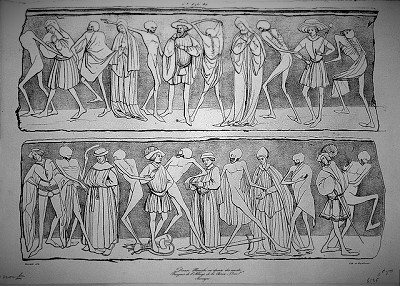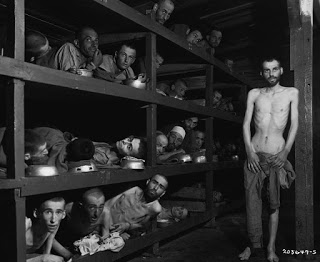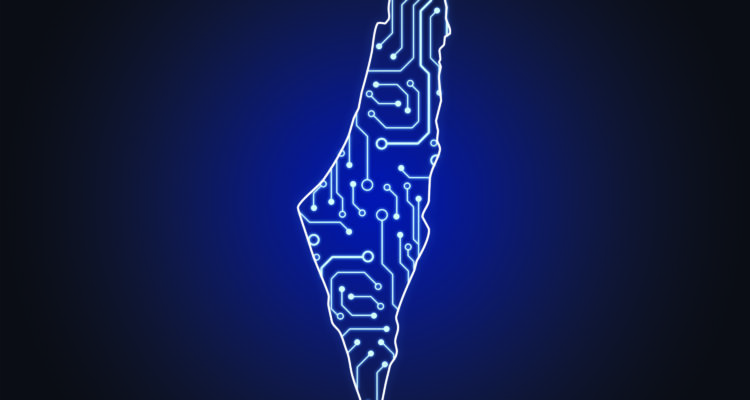 Angela Merkel finansuje zarówno Muzeum Auschwitz, jak i terroryzm
Angela Merkel finansuje zarówno Muzeum Auschwitz, jak i terroryzm
Judean Rose
Tłumaczenie: Małgorzata Koraszewska
 Danse Macabre ou danse des morts, Fresques de l’Abbaye de la Chaise-Dieu, Auvergne, Adrien Dauzats (1804-1868)
Danse Macabre ou danse des morts, Fresques de l’Abbaye de la Chaise-Dieu, Auvergne, Adrien Dauzats (1804-1868)
Angela Merkel odwiedziła Auschwitz, powiedziała, że się wstydzi i obiecała 60 milionów euro dla muzeum. Teoretycznie powinno to dawać satysfakcję jako widoczny wyraz niemieckiej, narodowej pokuty za Zagładę. W rzeczywistości zbliża się to do teszuwa, tefilla i cedaka* warunków wstępnych żydowskiej pokuty, jeśli zastąpisz modlitwę pielgrzymką.
W końcu, było tam publiczne przyznanie wstydu, a na dodatek duża donacja.Dla mnie jednak, a może i dla innych takich jak ja, wszystko to było zakłamane.Po pierwsze, wyglądało to na rzucanie pieniędzy umarłym. Umarli nie mogą użyć pieniędzy. Nie mogą im pomóc, niczego to dla nich nie zrobią. Te pieniądze nie robią także niczego dla ocalałych ani dla ochrony narodu żydowskiego.
Po drugie, ta symboliczna suma wydawała się szczególnym brakiem wyczucia: „Zabiliśmy 6 milionów spośród was, ale dajemy dziesięć razy tyle na dobroczynność, więc wszystko jest w porządku”.
 Co doprowadza nas do kolejnego powodu, by patrzeć nieufnie na tę wizytę i na tę donację. Czy nie byłoby lepiej, gdyby Merkel dała pieniądze Izraelowi; może na polepszenie warunków życia tych Izraelczyków, którzy znajdują się w szczególnie trudnej sytuacji?Wszyscy znamy zdjęcia żywych szkieletów z Auschwitz. Pieniądze na wyżywienie głodnych Żydów w Izraelu można by uznać za bliższe próby jakiegoś zrównoważenia tych obrazów, na zawsze utrwalonych w naszej kolektywnej świadomości.Nie. Nic nie może naprawić tego, co się zdarzyło, tego co oni zrobili. Ale pomoc żywym Żydom (nie zaś muzeom) z pewnością jest jednak odwrotnością mordowania ich.
Co doprowadza nas do kolejnego powodu, by patrzeć nieufnie na tę wizytę i na tę donację. Czy nie byłoby lepiej, gdyby Merkel dała pieniądze Izraelowi; może na polepszenie warunków życia tych Izraelczyków, którzy znajdują się w szczególnie trudnej sytuacji?Wszyscy znamy zdjęcia żywych szkieletów z Auschwitz. Pieniądze na wyżywienie głodnych Żydów w Izraelu można by uznać za bliższe próby jakiegoś zrównoważenia tych obrazów, na zawsze utrwalonych w naszej kolektywnej świadomości.Nie. Nic nie może naprawić tego, co się zdarzyło, tego co oni zrobili. Ale pomoc żywym Żydom (nie zaś muzeom) z pewnością jest jednak odwrotnością mordowania ich.
A ponieważ mówimy o tym, jak Niemcy mogłyby dobrze wydawać swoje pieniądze, doszliśmy do ostatniego powodu, dla którego propagandowa podróż Merkel do Auschwitz jest tak irytująca. Tym powodem są miliony euro, jakie federalny rząd Niemiec daje ruchowi Bojkot, Dywestycje i Sankcje (BDS); antyizraelskim organizacjom, takim jak Miftah (sponsorom antyizraelskiej podróży Ilhan Omar i Rashidy Tlaib, która się nie odbyła) i Adalah; i stowarzyszonym z organizacjami terrorystycznymi, takimi jak Ludowy Front Wyzwolenia Palestyny (LFWP), który zajmuje się zabijaniem Żydów. Tak to więc wygląda: wiemy, że Merkel obiecała 60 milionów euro na muzeum w Auschwitz, ale nie mamy żadnego pojęcia, ile milionów euro Niemcy dają organizacjom, które zmierzają do dzisiejszej wersji Ostatecznego Rozwiązania. Nie wiemy, ile milionów euro Niemcy obecnie inwestują w zabijanie Żydów, ponieważ – jak informuje NGO Monitor – federalne finansowanie w Niemczech jest niezmiernie nieprzejrzyste.
Być może jest tak umyślnie. Bo może istnieją rzeczy, o których nie chcą, byśmy wiedzieli. Niemcy prowadzili skrupulatne zapisy podczas wojny. Powiedzieli nam dokładnie, co zrobili Żydom, kiedy to zrobili i jak to zrobili. Obecnie nie chcą, byśmy wiedzieli, ile pieniędzy nadal, dzisiaj inwestują w zabijanie Żydów. Nie chcą, byśmy wiedzieli, ile pieniędzy rzucają arabskim grupom terrorystycznym – potoki pieniędzy, rzeki pieniędzy – by obrabowali Żydów z ich ziemi.
Dzisiaj, w cieniu ich historii, jest inaczej. Wolą nie mówić nam, ile wydają na doprowadzanie Izraelczyków do bankructwa i zmuszanie do zamykania przedsiębiorstw. Mają nadzieję, że Żydzi w Izraelu będą tak biedni, że nie będzie ich dłużej stać na żywność. Kiedy tak się stanie, zacznie się głód, który zmusi Żydów do opuszczenia Izraela, zostawiając go wrogom Izraela. Niemcy wydają na to miliony euro. Miliony. Ile milionów wie tylko Merkel i Bóg. Dzisiaj bowiem niemiecki rząd woli zacierać swoje ślady, żebyśmy nie zobaczyli, ile pieniędzy nadal daje dzisiaj terrorystom, którzy mordują Żydów pociskami zamiast Cyklonem B.
Z drugiej strony jednak, Niemcy chcą, byśmy wiedzieli, że dadzą 60 milionów euro na utrzymanie muzeum w Europie, gdzie Niemcy kiedyś samodzielnie zabili i zagłodzili Żydów, nie płacąc wówczas innym, by zrobili to za nich.
Nie ma nic złego w muzeach, nic złego w edukacji o Zagładzie – musimy uczyć się lekcji z przeszłości. Jest jednak wyłącznie zło w finansowaniu jedną ręką edukacji o Zagładzie i równoczesne płacenie milionów euro kompanom LFWP drugą ręką. To są dzisiejsze Niemcy. Niemcy, gdzie rząd federalny nadal finansuje Ostateczne Rozwiązanie i robi to z tego samego źródła pieniędzy, z którego sfinansuje muzeum w Auschwitz.
Wiedząc to wszystko, co możemy zrozumieć z niemieckiej pokuty za Holocaust?
*skrucha, modlitwa i dobroczynność
Zawartość publikowanych artykułów i materiałów nie reprezentuje poglądów ani opinii Reunion’68,
ani też webmastera Blogu Reunion’68, chyba ze jest to wyraźnie zaznaczone.
Twoje uwagi, linki, własne artykuły lub wiadomości prześlij na adres:
webmaster@reunion68.com




